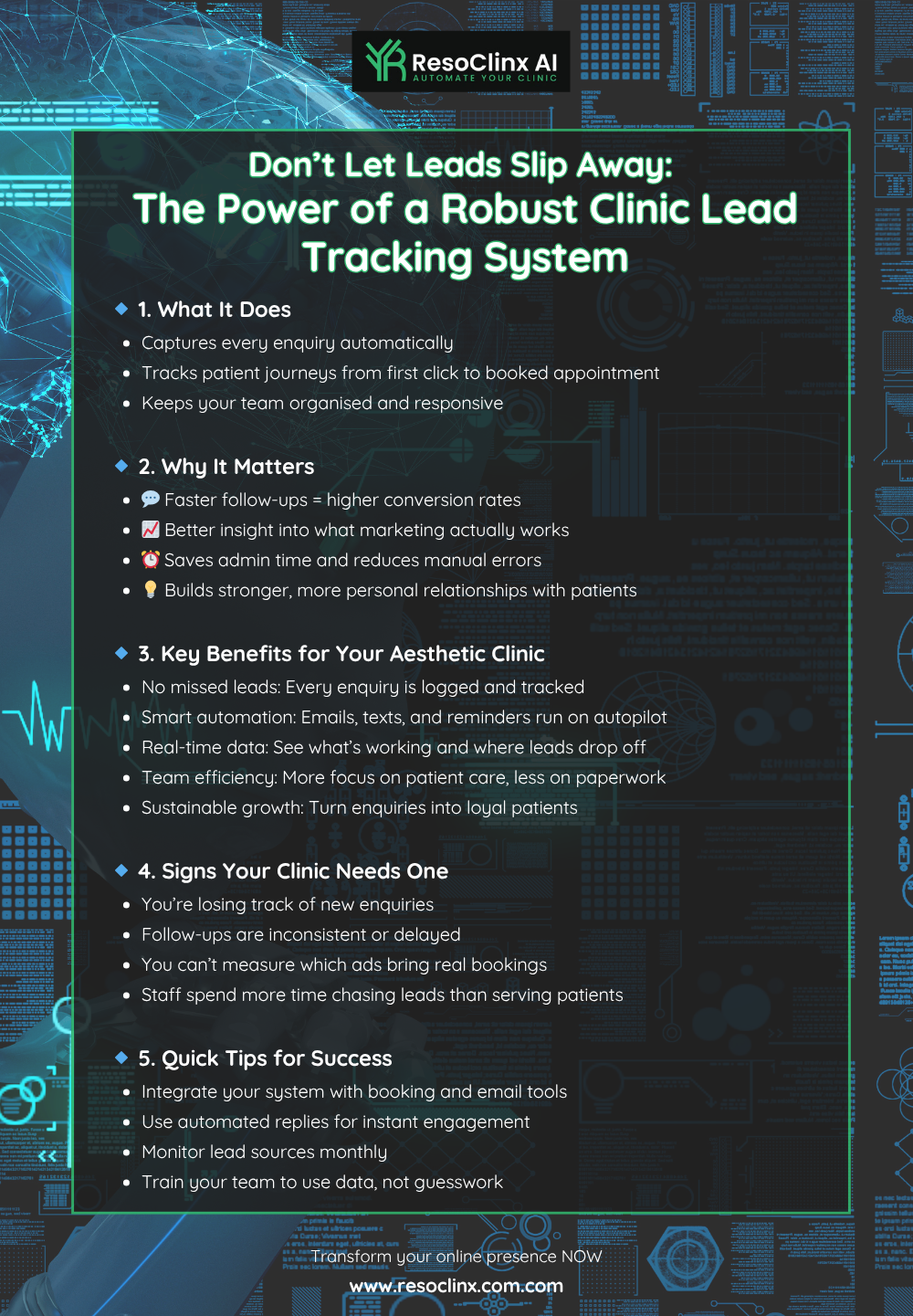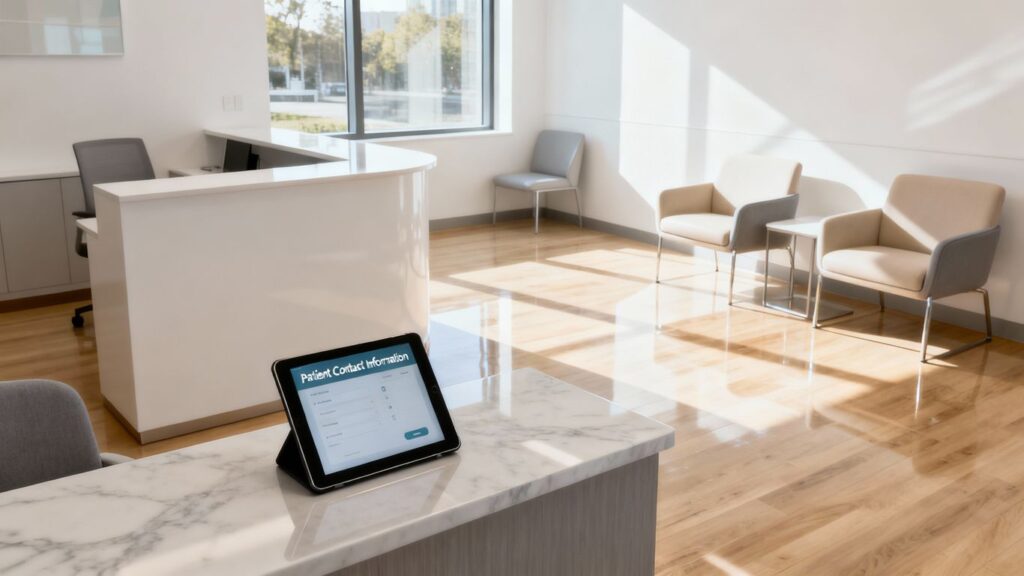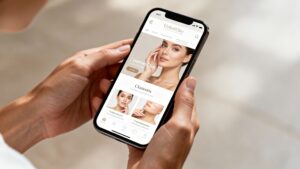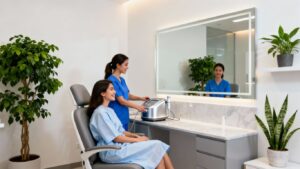Running a successful aesthetic clinic involves more than delivering excellent treatments. It’s equally about ensuring potential clients can find you easily, access the right information, and feel confident when booking an appointment.
This is where an effective clinic lead tracking system becomes essential. Think of it as your clinic’s digital assistant—helping you capture, organise, and nurture every enquiry so that no opportunity is missed.
In this article, we’ll explore how to implement the right system and make it work seamlessly for your business.
Key Takeaways
- Identify where your clinic leads originate and how they move through your patient journey to improve your sales and conversion process.
- Implementing a well-designed clinic lead tracking system can automate routine tasks, free up staff time, and ensure timely follow-ups.
- Leveraging technology and AI enables more personalised communication and a smoother booking experience for your patients.
- Consistent, relevant communication helps build trust and long-term relationships with your patients.
- Tracking and analysing key metrics helps identify where leads are lost, allowing you to make data-driven decisions to grow your aesthetic clinic.
Understanding Your Clinic’s Lead Tracking Needs

If your aesthetic clinic isn’t growing as expected, the problem might not be attracting new patients—but managing the ones already showing interest. Today’s patients have plenty of options and expect quick, personalised responses.
If your clinic doesn’t reply promptly or follow up with relevant information, they may simply move on. Understanding your lead tracking needs is therefore crucial to improving conversion and retention.
Identifying Key Lead Sources for Your Practice
Many clinics assume they know where their leads come from—but assumptions can be misleading. Identifying your most effective lead sources is the first step towards focusing your aesthetic clinic marketing efforts and budget where they deliver the greatest return.
Are most of your new patients discovering your clinic through your website, social media ads, referrals, or local collaborations? Understanding this helps you allocate resources more strategically.
Common lead sources include:
- Website enquiries: Contact forms, live chat, or calls generated directly from your site.
- Social media: Leads generated from Facebook, Instagram, or TikTok through ads or organic engagement.
- Referrals: Patients recommending your clinic to friends and family.
- Online advertising: Google Ads, social campaigns, or other digital marketing channels.
- Local partnerships: Collaborations with spas, hair salons, or dermatologists.
- Offline marketing: Local events, printed materials, or word-of-mouth.
Mapping the Patient Journey from Inquiry to Appointment
Consider the journey a potential patient takes—from the moment they start researching a treatment to the point of booking an appointment. This path can often be complex and non-linear.
They might see an ad, visit your website, read reviews, perhaps call with a question, and then decide to book. Understanding each step helps you see where you can make the experience smoother and more appealing. If the process feels confusing or time-consuming, many potential patients will abandon it entirely.
Consider these stages:
- Awareness: The potential patient realises they have a concern or desire a treatment.
- Consideration: They start researching clinics and options.
- Inquiry: They reach out to your clinic with questions.
- Consultation: They have an initial discussion about treatments.
- Decision: They choose your clinic for their procedure.
- Booking: They schedule their appointment.
Recognising Where Leads Are Being Lost
This is often the most eye-opening part. “Lead leakage” refers to when potential patients drop out of your sales process at any stage before booking an appointment.
It could be due to slow response times, a confusing booking system, or a lack of follow-up. Identifying these leakage points allows you to take targeted action—plugging the gaps and converting more enquiries into paying patients.
Common areas where leads are lost:
- Slow initial response: Not getting back to inquiries within a few hours.
- Lack of clear information: Potential patients can’t easily find answers to their questions on your website.
- Difficult booking process: Online booking is clunky, or phone lines are often busy.
- Inconsistent follow-up: Leads aren’t contacted regularly or with relevant information.
- Poor communication: The tone or content of messages doesn’t build confidence.
If your clinic isn’t growing as expected, it’s often not about finding leads, but about managing them effectively. Patients want fast, personal communication. If you can’t provide that, you’re likely losing them to competitors. A good lead tracking system helps you capture, nurture, and convert these valuable inquiries without adding to your team’s workload.
Implementing A Robust Clinic Lead Tracking System

You may have plenty of enquiries coming in—but are you effectively tracking and managing them?
It’s easy to get caught up in the day-to-day running of the clinic, but if you’re not organised about your leads, you’re essentially leaving money on the table. This section is all about getting a solid system in place to make sure every potential patient gets the attention they deserve.
Choosing the Right Clinic Lead Tracking System
Choosing the right system can feel overwhelming—there are countless options, all claiming to be the best. The key is not to choose the most feature-heavy tool, but one that truly fits your clinic’s workflow.
Think about what you actually need. Are you a solo practitioner or part of a larger group? What’s your budget? What kind of treatments do you offer? Answering these questions will help narrow down the field.
Some systems are really basic, just helping you log calls and appointments. Others are much more advanced, with features like automated follow-ups, patient journey mapping, and even AI-powered reminders. For aesthetic clinics, a system that can handle the specific patient journey, from initial inquiry about a popular treatment to post-procedure follow-up, is a real game-changer.
Look for something that integrates well with your existing tools, like your booking software or website, to avoid double-entry and keep things running smoothly.
Automating Lead Capture and Initial Contact
This is where things get really exciting. Manual lead capture? It’s a thing of the past, really. Imagine a potential patient fills out a form on your website asking about a specific treatment. Instead of someone having to manually check that form, log it, and then call them back, an automated system can do it all.
It can capture the lead directly from your website, social media, or even online ads, and then immediately send out a personalised welcome email or text message. This speed is absolutely vital; the faster you respond, the higher your chances of converting that lead.
Your system should also capture leads directly from your Google Business Profile (GBP)—an essential tool for local SEO for clinics. When potential patients find your clinic on Google, automation ensures their enquiries flow straight into your lead management dashboard for faster follow-up.
Think about it: a potential patient is interested now. If they have to wait hours, or even a day, for a response, they might just go somewhere else. Automation means you can acknowledge their interest instantly, perhaps even providing some initial information about the treatment they enquired about. This not only saves your team a massive amount of time but also makes a fantastic first impression. It shows you’re organised, efficient, and ready to help.
Streamlining Follow-Up Processes
Okay, so you’ve captured the lead and made initial contact. What next? This is where many clinics stumble. Leads often go cold when follow-up is inconsistent or delayed. A structured system ensures every enquiry receives timely and relevant communication.
A good lead tracking system will help you set up automated follow-up sequences. This means that after the initial contact, the system can automatically send out a series of emails or texts over the next few days or weeks. These might include:
- Information about other relevant treatments.
- Testimonials from happy patients.
- Special offers or promotions.
- Reminders about booking a consultation.
These automated follow-ups aren’t just about sending messages; they should be smart. The system can track how the lead interacts with these messages – did they open the email? Did they click on a link? This information helps you understand their level of interest and tailor future communication. You can also set up tasks for your team to make manual follow-up calls or send personalised messages at key points in the patient’s journey. It’s about creating a consistent, nurturing experience that guides them towards booking an appointment without feeling pressured.
Leveraging Technology For Enhanced Lead Conversion
It’s easy to get caught up in the day-to-day running of your clinic, but if you’re not actively converting leads into patients, you’re leaving money on the table. Technology can be a real game-changer here, helping you work smarter, not harder. Think of it as giving your sales process a much-needed upgrade.
Always ensure any system you use complies with UK data protection laws (GDPR) when storing or automating patient information.
Utilising CRM Features for Nurturing Leads
Customer Relationship Management (CRM) systems are more than just digital address books.
They’re powerful tools for keeping potential patients engaged. When someone makes an inquiry, your CRM can automatically send them a welcome email, perhaps with some general information about your most popular treatments.
As they interact more – maybe by visiting specific pages on your website or downloading a brochure – the CRM can learn their interests. This allows you to send them more targeted information, like case studies or testimonials related to the treatments they’ve shown interest in.
It’s about building a relationship over time, providing helpful content that answers their questions before they even ask them. This consistent, relevant communication keeps your clinic top-of-mind without you having to manually track every single interaction.
The Power of AI-Driven Reminders and Personalisation
Artificial intelligence (AI) is no longer just a buzzword; it’s a practical tool that can significantly boost your lead conversion rates.
Imagine a system that automatically sends a reminder text message to a potential patient a few days before their scheduled consultation, or even a personalised email offering a special discount for booking a treatment within the next week.
AI can analyse patient behaviour and preferences to tailor these communications. For instance, if a lead has been researching a specific procedure for a while, AI can trigger a prompt to book a consultation or offer a limited-time incentive.
This level of personalised attention makes potential patients feel valued and understood, making them much more likely to proceed with booking.
Integrating Your System for Seamless Operations
For technology to truly work for you, it needs to work together. Integrating your lead tracking system with other clinic software, like your appointment scheduler or patient management system, is key.
This means that when a lead converts into a patient, their information flows smoothly from your lead tracking system into your scheduling software. No more double-entry or lost details. This integration creates a unified view of your patient journey, from the very first inquiry to their follow-up appointments.
It streamlines your entire workflow, reduces the chance of errors, and frees up your staff to focus on providing excellent patient care rather than administrative tasks.
A well-integrated system ensures that no lead falls through the cracks.
Here’s a quick look at how integration helps:
- Automated Data Transfer: Information moves between systems without manual input.
- Unified Patient View: All patient interactions and history are in one place.
- Reduced Administrative Burden: Staff spend less time on data entry and more time with patients.
- Improved Efficiency: Processes from lead capture to appointment booking become smoother.
Maximising Patient Engagement Through Your System
Once a lead has entered your system, the real work of turning them into a loyal patient begins.
It’s not just about booking an appointment; it’s about making them feel valued and understood from the very first interaction.
This is where your lead tracking system truly shines, acting as the central hub for all patient communication and relationship building.
Personalised Communication Strategies
Generic, one-size-fits-all messages no longer resonate with today’s patients. Patients expect a personal touch, and your system can help you deliver just that.
By segmenting your leads based on their interests, previous inquiries, or even their stage in the patient journey, you can tailor your communications. Did someone inquire about a specific facial treatment?
Send them information tailored to that, perhaps with a special introductory offer. Are they a returning patient considering a new procedure?
Remind them of their previous positive experiences and highlight how the new treatment complements their goals.
- Automated Welcome Emails: Send personalised welcome emails that acknowledge their enquiry and provide useful next steps.
- Targeted Content: Send relevant blog posts, testimonials, or treatment information based on their expressed interests.
- Birthday & Anniversary Messages: Use your system to send automated well wishes and perhaps a small discount to celebrate their special days.
The key is to make each communication feel like it’s specifically for them, not just another broadcast message. This builds rapport and shows you’re paying attention to their individual needs and desires.
Optimising Appointment Booking and Reminders
Fewer no-shows and a smoother patient experience start with an efficient booking process.
Your lead tracking system should integrate with your scheduling tools to make this as easy as possible. Online booking options are a must, allowing patients to see availability and book at their convenience.
Beyond that, automated reminders are a lifesaver. Sending timely reminders via text or email can significantly reduce missed appointments.
These reminders can be configured to be sent at different intervals – perhaps a confirmation immediately after booking, a reminder a week before, and a final one a day or two prior.
Example of Automated Appointment Reminder Sequence:
| Reminder Type | Timing | Purpose |
|---|---|---|
| Confirmation | Immediately after booking | Confirms details and provides clinic contact info |
| Pre-Appointment | 2–3 days prior | Reduces no-shows and allows time for rescheduling |
| Day-Before | 24 hours prior | Final reminder to confirm attendance |
Building Lasting Patient Relationships
Engagement doesn’t stop after the appointment. Your lead tracking system is instrumental in nurturing long-term relationships.
Post-treatment follow-ups are vital. A simple automated message asking how they’re recovering or if they have any questions can make a huge difference.
Encourage reviews and feedback – happy patients are often willing to share their positive experiences, which can then be used as testimonials.
By consistently providing personalised communication and excellent service, you transform a one-time lead into a lifelong advocate for your clinic.
Measuring Success With Data-Driven Insights

After implementing your lead tracking system, the next step is measuring its impact.
Data-driven insights reveal which parts of your aesthetic clinic marketing strategy are working and where leads may be dropping off.
Think of it as your clinic’s performance dashboard—showing what’s effective and where you can improve.
Key Metrics for Lead Conversion and Revenue
To really understand your system’s performance, you need to track specific metrics. These aren’t just random numbers; they tell a story about your patient journey and your clinic’s financial health.
Focusing on these will help you see the direct impact of your lead management efforts.
Here are some of the most important ones to keep an eye on:
- Lead Source Effectiveness: Where are your best leads coming from? Is it your website, social media, referrals, or local advertising? Knowing this helps you focus your marketing budget where it counts.
- Conversion Rate: This is the percentage of leads that actually become paying patients. A low conversion rate might mean your follow-up process needs work, or perhaps the initial contact isn’t compelling enough.
- Cost Per Lead (CPL): How much does it cost you to acquire each new lead? Comparing this across different sources can show you which marketing channels are most cost-efficient.
- Cost Per Acquisition (CPA): Similar to CPL, but this measures the cost to turn a lead into a booked appointment or a paying patient. This is a really good indicator of your overall sales efficiency.
- Average Patient Value: What’s the average amount a patient spends with your clinic over time? Understanding this helps you see the long-term value of each successful lead.
- Revenue Generated Per Lead Source: Which sources are bringing in the most money, not just the most leads? This is a direct measure of ROI.
It’s vital to track these metrics consistently to spot trends and understand what’s truly driving growth.
Analysing Lead Leakage for Improvement
Lead leakage is like having tiny holes in a bucket – all your hard work is slowly draining away. It happens when a potential patient drops out of the sales funnel at some point between their initial inquiry and booking an appointment. Identifying these ‘leakage points’ is key to plugging those holes and converting more inquiries into actual appointments.
Common places where leads might leak out include:
- Slow Response Times: If a patient enquires and doesn’t hear back quickly, they might go elsewhere.
- Unclear Information: If your website or initial communications don’t clearly answer their questions about treatments, pricing, or availability, they might get frustrated and leave.
- Difficult Booking Process: A complicated or lengthy online booking system can deter potential patients.
- Lack of Follow-Up: Leads that aren’t nurtured or followed up on consistently can simply go cold.
- Poor Communication: If the tone is off, or if the communication feels impersonal, patients might not feel a connection to your clinic.
By mapping out the patient journey within your system, you can pinpoint exactly where these drop-offs are occurring. Once identified, you can implement targeted strategies to address each specific issue, whether it’s automating initial responses, simplifying the booking process, or training your team on better follow-up techniques.
Utilising Real-Time Reporting for Strategic Decisions
Having data is one thing, but being able to see it when it matters is another. Real-time reporting means you’re not looking at outdated information. You can see what’s happening now, which allows you to make smart, timely decisions about your clinic’s strategy.
Your lead tracking system should provide a dashboard that gives you a clear overview. This might include:
- Live Lead Volume: See how many new inquiries are coming in each day or week.
- Appointment Bookings: Track how many appointments are being scheduled in real-time.
- Campaign Performance: Monitor the immediate impact of any marketing campaigns you’re running.
- Staff Performance: See how quickly your team is responding to leads and moving them through the funnel.
This kind of immediate feedback is incredibly useful. If a particular marketing channel suddenly spikes in leads, you can see it and allocate resources accordingly. If appointment bookings dip unexpectedly, you can investigate why right away. It moves you from guessing to knowing, allowing for agile adjustments that can significantly impact your clinic’s success.
The Future Of Clinic Lead Management

The world of aesthetic clinics is always moving, and what works today might be a bit old-fashioned tomorrow.
So, how do we keep up and make sure our clinics are not just surviving, but really thriving?
It’s all about looking ahead and being ready for what’s next in how we connect with potential patients.
Adapting to Evolving Patient Expectations
Patients today are more informed and have higher expectations than ever before.
They want quick responses, personalised communication, and a smooth journey from their first thought about a treatment to actually booking it. If your clinic isn’t meeting these demands, you’re likely losing out. Think about it: people are used to instant gratification online, and they expect the same from your clinic.
This means your lead tracking system needs to be super responsive. It should be able to capture inquiries instantly and start a conversation right away, perhaps with an automated welcome message or a quick follow-up from a team member.
The Role of Continuous Education in Lead Management
Just like staying updated on the latest aesthetic treatments, keeping your lead management skills sharp is vital.
The technology and strategies for attracting and converting leads are constantly changing. Are you and your team up-to-date with the latest CRM features, digital marketing trends, or even how AI can help streamline your follow-ups?
Investing in training for your staff on these systems is not a luxury; it’s a necessity. It ensures that your clinic is using the most effective methods to engage with potential patients and turn them into loyal clients. Think of it as an ongoing professional development for your business.
Scaling Your Practice with Advanced Systems
As your clinic grows, so does the complexity of managing leads. What worked for a handful of inquiries might not cut it when you’re dealing with hundreds.
This is where advanced lead tracking and CRM systems become indispensable. These systems can handle a higher volume of leads, automate more complex follow-up sequences, and provide deeper insights into what’s working.
They can help you manage multiple locations, track campaign performance across different channels, and even predict future lead generation needs.
Ultimately, the right technology allows you to scale your practice efficiently without sacrificing the personal touch that patients expect.
Here’s a look at how advanced systems support growth:
- Automated Workflows: Set up complex sequences for different lead types (e.g., new inquiry vs. returning patient).
- Data Analytics: Gain deeper insights into lead sources, conversion rates, and patient lifetime value.
- Integration Capabilities: Connect your CRM with scheduling, marketing, and other practice management software for a unified view.
- Scalable Infrastructure: Ensure your system can handle increased volume as your practice expands.
The future of clinic lead management isn’t just about having a system; it’s about having a smart, adaptable system that grows with you and anticipates the needs of your patients.
Building a Stronger Practice
Running an aesthetic clinic today is as much about communication and organisation as it is about clinical skill.
A well-implemented lead tracking system helps you manage every enquiry efficiently, nurture potential patients with timely and relevant communication, and make informed decisions that support sustainable growth.
With the right tools and consistent follow-up, your clinic can stay organised, responsive, and focused on what matters most—delivering exceptional care and building long-term patient relationships.
Frequently Asked Questions
What exactly is a lead tracking system for a clinic?
A lead tracking system acts as your clinic’s organiser. It records and manages every person who shows interest in your services—from their first enquiry to becoming a patient. It allows you to track where leads originated, what treatments they’re interested in, and ensures that no potential patient is overlooked.
Why is tracking leads so important for aesthetic clinics?
With growing competition in the aesthetic industry, lead tracking helps you identify which marketing efforts are driving real results. It also enables faster, more personal follow-up—helping potential patients choose your clinic with confidence.
How can a lead tracking system help me understand my patients better?
By tracking where your leads originate—such as social media, your website, or patient referrals—you gain valuable insights into your ideal audience. This information allows you to tailor both your aesthetic clinic marketing and your services to meet real patient demand.
What's the difference between a basic tracker and a more advanced system?
A basic tracker may simply record names and contact details, while an advanced CRM (Customer Relationship Management) system can automate follow-ups, track interactions, and provide valuable insights across your entire patient journey.
Can a lead tracking system help my staff be more efficient?
Yes. Instead of your staff spending time searching through notes or spreadsheets, a good lead tracking system keeps everything organised in one place. It can automatically assign leads, set follow-up reminders, and provide all relevant information instantly.
How do I know if my lead tracking system is actually working?
You measure it. A good system will show you key numbers, like how many leads you're getting, how many are turning into appointments, and how much money those leads are bringing in. You can also see if leads are 'leaking' out – meaning people are interested but not booking – and then figure out how to fix that.






